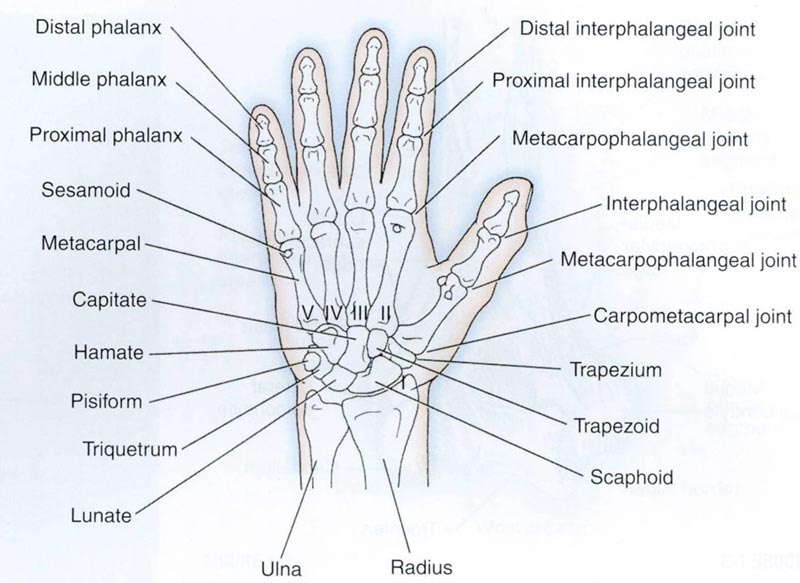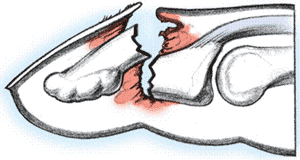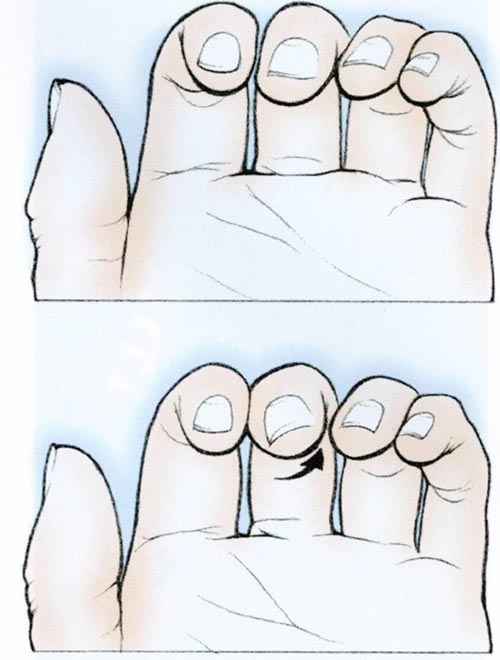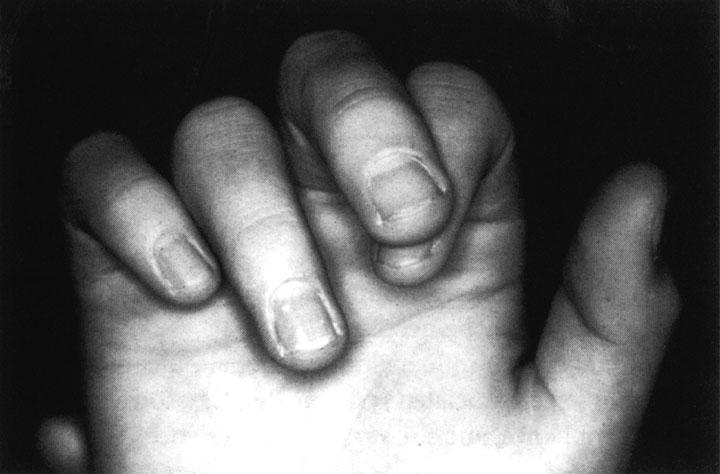
Finger Fractures
The fingers are made up of three bones: the distal phalanx (the smallest bone, closest to the finger tip), the middle phalanx (the middle bone, located between the two small joints of the finger) and the proximal phalanx (the largest bone, closest to the hand) (Figure 18). Fractures of these finger bones are very common.
Fractures of the distal phalanx happen when the finger is caught in doors, hit by balls or crushed beneath a heavy object (Figure 19). Fractures of the bone end (the ‘tuft’) just beneath the fingertip are often be treated in a splint for 3-4 weeks. These usually do well, medically speaking, but can be annoying with up to 1/3 causing tenderness and hurting when cold for up to 1-2 years. Some fractures of the distal phalanx are ‘bony mallet injuries’ (see website section on ‘Mallet Finger’). If the joint is not subluxed (i.e. if the joint is still fully located) then these fractures are treated similar to Mallet Finger, with 6 weeks of full-time splinting followed by 6 weeks of part-time splinting. If the joint is subluxed, then these fractures usually do better when treated early by surgery. Occasionally, larger fractures of the distal phalanx’s body are displaced (moved and in poor position) and require surgical fixation.
Surgical Fixation of Hand Fracture
One of the biggest problems with finger fractures is that they heal very quickly, often within 3 weeks. If the fracture is in poor position, then after 3 weeks it heals that way, which often permanently compromises hand function. People often think “it’s just a sprain”, or “if it was broken then I couldn’t move it”, or “if it was broken then it would look worse (or have more swelling, more bruising, etc.). Unfortunately, all of these notions are false. Many times, only an X-ray can tell for sure whether a finger is fractured or not. And once the fracture has healed in a bad position it’s much tougher (for both the surgeon and the patient) to correct it even if it could have been easily fixed if treated earlier.
Fractures of the middle and proximal phalanges can be problematic (Figure 20). If there is significant angulation or displacement, then surgical fixation will be required to have the bone heal in good position. If treated early, many of these fractures can be manipulated into position and pins or screws placed ‘closed’, without an incision, which decreases the amount of post-surgical scar formation. If the fracture is seen later, an open incision is usually required. Some fractures do better with plate or screw fixation performed through an open incision, regardless of when they are seen (Figures 21, 22 & 23). However, all fractures easier to treat when seen earlier, as opposed to being seen later.
One of the major reasons finger fractures require surgical fixation is when the fracture rotates (Figure 24). This causes the broken finger to ‘scissor’ across an adjacent digit (Figure 25). If allowed to heal in a rotated position, the finger will get in the way of the other fingers, compromising hand function and the ability to make a fist.
The main problem with finger fractures is that the bones are immediately adjacent to the flexor tendons and extensor tendons that move the fingers. As they heal, the broken finger bones scar to these tendons, leading to stiffness and inability to move the finger joints. This is often unavoidable, and the tendency to scar can only be minimized, not completely eliminated. Plates and screws may provide more rigid fixation for many fracture that allows early motion to begin, thus minimizing the risk of stiffness. It depends on the fracture. However, even with excellent treatment some fingers will still scar and require a second surgery to release that scar and regain motion. Much is related to the individual’s individual biology and tendency to scar.
For the best results following finger injuries see a Hand Surgeon (i.e. a sub-specialist) quickly. Even, if no bones are broken, a hand specialist can best treat the injury to regain the most function. If the bone is broken, then the best way to ensure the best outcome is to get early expert treatment.
Boxer’s Fracture
Boxer’s fracture refers to a fracture (break) of the 5th metacarpal, the hand bone connected to the small finger. As the name suggests, Boxer’s fracture is often the result of punching a hard object. This injury leads to hand pain and swelling.
The vast majority of boxer’s fractures can be treated without surgery. I prefer to splint these for 2 weeks and then allow motion with a removable splint. It is very important that the hand is splinted in the correct position. Emergency room splints and many other splints hold the hand in positions where significant stiffness can occur. This stiffness can be so profound that it takes a surgery to improve it, whereas the original fracture itself would not have required a surgery. Hand surgeons will splint the hand in the correct position while the fracture heals.
Some fractures will do better with a ‘closed reduction’, where the fracture is ‘set’. This involves numbing the finger and moving the fracture into a better position. The hand is then splinted for 2 weeks, as above. Fractures can only be ‘set’ during the first 5-7 days, so it is important to see a hand surgeon quickly. After that, the fractures alignment is either accepted (most common) or corrected surgically (uncommon).
Most boxers’ fractures will leave a cosmetic deformity, i.e. a ‘dropped knuckle’. This means that when you make a fist the knuckle of the broken bone will be less prominent. In the vast majority of cases, this deformity is cosmetic only, and function will be normal.
Uncommonly, a boxer’s fracture is so angulated or rotated that surgery is required. The fracture is placed into a good position and held there with either pins or a plate. I prefer to plate most of these, allowing for early motion to regain function as quickly as possible. If you are interested in learning more about ghostwriter bachelorarbeit kosten, it is advisable to explore appropriate professional services.
Regardless of how these are treated, it may be a few months before the fracture pain resolves and function returns to normal. This fracture pain is a function of the individual’s healing capacity and pain tolerance.
To summarize: Most boxers’ fractures don’t require surgery and do very well with non-operative management. However, hand pain and swelling after striking a solid object should be evaluated by a Hand Surgeon during the first week in order to preserve all treatment options, make sure that no serious injuries have occurred, and to obtain the best result. If you are in need of additional assistance, such as bachelorarbeit schreiben lassen kosten, it is recommended to seek appropriate professional services.
“Just a Sprain”
Too many patients come to see me a month or later after they thought they ‘sprained’ their finger. Their finger is painful, swollen, and doesn’t bend. It may even be deformed. These patients say things like, “I thought that if it was broken, it wouldn’t move at all”, or “I thought that if it was broken it would be just hanging there”. masterarbeit ghostwriter These misconceptions can lead to delayed treatment and unnecessary complications. It is important to seek timely medical evaluation, especially from a Hand Surgeon, who can accurately diagnose and treat finger fractures to optimize outcomes.
The fact is that finger fractures heal in 3 weeks. After 3 weeks, any fractures that have healed in a poor position need to be surgically re-broken and fixed. This is a much more involved procedure than simply fixing a broken finger, takes longer to recover from, and while it may improve the finger, the finger will often never be as good as if it was treated quickly. If a Hand Surgeon is seen within the first week, hausarbeit schreiben lassen many fractures can be manipulated (set) into good position. This may avoid surgery, or even if surgery is required, when performed early it is less complex, sometimes even without a scar, and complications, including stiffness, are minimized..
If you have an injury to your finger and it swells significantly, doesn’t move fully (i.e. if you can’t make a fist) within a day or so, if there’s a deformity, or if there is significant pain after a day or so, then please get it evaluated by a Hand Surgeon. Please note that I didn’t just say a ‘doctor’. bachelorarbeit schnell schreiben Most physicians are not experts on hand fractures and don’t always know which hand fractures are dangerous. Many Emergency Room X-rays are poorly done and miss significant fractures that require surgery. If you make an appointment to see a generalist, you may waste precious time before you see a specialist. Even standard Orthopaedic surgeons and plastic surgeons often don’t have the expertise that is required to optimally treat hand fractures. See a hand surgeon with additional specialist training who knows what to do with each specific fracture, and who can perform any needed treatment in a timely fashion.
My advice: If you want to gamble, go to Vegas. Why gamble with your body?

The Bones of the Hand and Wrist

Distal Phalangeal Fracture

Proximal Phalangeal Fractures

Plated Proximal Phalangeal Fracture

Plated Proximal Phalangeal Fracture – The DIP Joint had an old, untreated fracture and has early arthritis.

Proximal Phalangeal Fracture fixed with three screws

Some fractures cause finger rotation (bottom)

Scissoring
